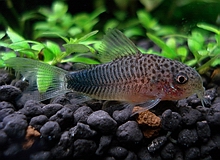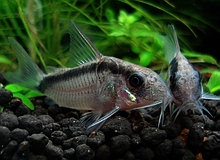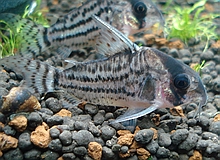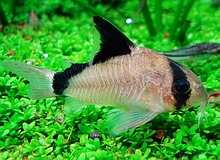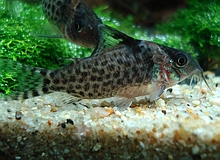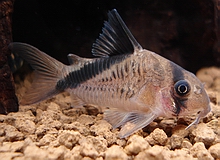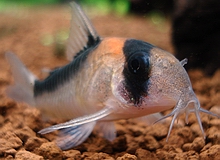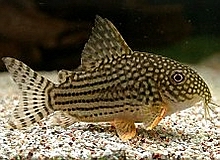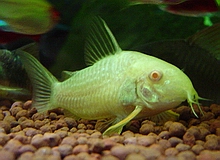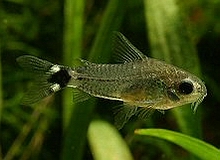Corydoras
is a large genus of neotropical fishes with over 150 identified species,
belonging to the Armored Catfish Family Callichthyidae. Most species
are generally found in small streams, along the margins of larger rivers,
in marshes and ponds. They are native to slow moving streams and small
rivers of South America where the water is usually shallow and very
clear. Corydoras display a broad diversity of body shapes and coloration
and the size range between 1-5 inches in length. Like catfish, most
Corydoras has barbels, which are used to forage for food in sand, gravel,
or detritus. The banks and sides of the streams are covered with a dense
growth of plants, and this is where the corys are found. They inhabit
a wide variety of water types but tend toward soft, slightly acidic
waters. In the wild, they are active during daylight and often seen
in shoals. Most species prefer being in groups and many species are
found in schools or aggregations of hundreds or even thousands of individuals,
usually of a single species, but occasionally with other species mixed
in.
In the aquarium, most corys prefer soft, acidic waters, pH range between
5.5 - 6.8. However, they can tolerate a wide range of water conditions
including temperatures that are cooler, but do not do well in fish tanks
with high nitrate levels. This ion leads to the infection of the barbels,
which will shorten and become useless. These are easy fish to keep,
being peaceful, small, hardy, active, and entertaining. Occasionally
they will dart to the surface, sticking their snout above the water
for an instant, appearing to take a "breath" of fresh air.
They are well suited to tropical freshwater community aquariums, as
they get along well with other species and are not at all aggressive.
Corys are shy fish and it is recommended to keep them in groups of at
least six as most species seem to form shoals in the aquarium.
In their natural habit, their main food is bottom-dwelling insects,
insect larvae and various worms, as well as some vegetable matter. In
the aquarium, Corys are mostly bottom feeders, so they should be offered
sinking pellets as well as supplements of live and frozen foods. Sexing
can be difficult at a young age but mature females grow longer (and
wider) than the males. The rounded belly of the female keeps her nose
off the gravel when she rests. They usually take two years to attain
breeding size, but some species breed earlier. Some corydoras species
have been reported to live up to 15 to 20 years.
|

